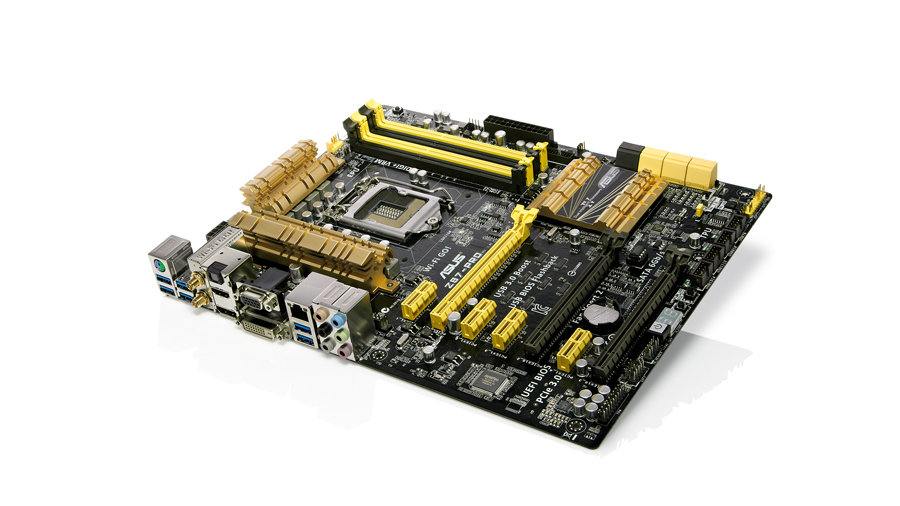TechRadar Verdict
Pros
- +
Fully featured Z87 board
- +
Good performance
- +
Full overclocking options
- +
LED debug screen
- +
BIOS boot button
Cons
- -
Lacks some of the features of rival boards
Why you can trust TechRadar
Here it is, then - our first taste of Asus's new Z87 generation, replete with fancy gold medallion accessories. Actually that's a bit unfair, because this board is pretty low-key if you look past the gaudy detailing.
That's not something we can say about all the new Haswell-compatible boards we viewed at a recent Asus event. Whether it was pointless RFID kit or bizarre slide-out remote control devices, there was a feeling of desperation to come up with something - hell, anything - to make its motherboards truly stand out from the varied competition on the motherboard market.
By the end of the show, we'd barely have batted a bag of SATA cables had Asus wheeled out a motherboard with a mini drinks dispenser as a final flourish. No doubt we'll soon get our hands on some of those more exotic models, but for now it's the sensible-shoes Z87-Pro we're dealing with.
Goodness, even the name is blessedly short and concise. So what do you get?
Standard Intel Z87 chipset gubbins in an ATX form factor, for starters. That's a good thing, because it means full access to all features of any compatible Intel chip for the new LGA1150 socket. Graphics, overclocking, QuickSync - the lot.
Then there are six native SATA 6Gbps ports, and six USB 3.0 sockets. Ditto the graphics support, which takes in dual x16 slots. For the record, the third physical x16 slot hooks into the PCH chip, and thus only offers four PCI Express 2.0 lanes. Fine for most peripherals, but not a goer for graphics.
Oh and while we're talking graphical grunt, there's a full compliment of video-out options – DVI, HDMI and DisplayPort, to name but a few.
Sign up for breaking news, reviews, opinion, top tech deals, and more.
Straight to it
Anyway, let's get onto what's specific about the Z87-Pro. There's decent clearance around the socket for your cooling solution of choice and Asus has provided some pretty chunky hunks of metal to cool the MOSFETs, though there's no facility for hooking up water cooling for the board and chipset itself.
Then there's an N-spec Wi-Fi adapter, which combines with the standard Intel gigabit Ethernet port to cover all your network adapter options. Next up is a physical power switch, an LED debug display and a button that takes you straight into the BIOS on boot, all of which we're pretty keen on.
There are some new features, too, including the ability to store text notes. For example, you could store reminders about optimal settings, and a modifications log that keeps tabs on the changes you make - pretty neat. That just leaves us with the minor matter of performance.
Benchmarks
Single threaded performance
Cinebench R11.5: Index score: Higher is better
ASUS Z87-PRO: 1.76
GIGABYTE G1.SNIPER M5: 1.72
INTEL DZ87KLT-75K: 1.77
ASUS SABERTOOTH Z77: 1.64
Memory bandwidth performance
SiSoft Sandra: GB/S: Higher is better
ASUS Z87-PRO: 17.47
GIGABYTE G1.SNIPER M5: 17.45
INTEL DZ87KLT-75K: 17.56
ASUS SABERTOOTH Z77: 16.41
Gaming performance
Shogun 2: FPS: Higher is better
ASUS Z87-PRO: 38.1
GIGABYTE G1.SNIPER M5: 37.1
INTEL DZ87KLT-75K: 37.9
ASUS SABERTOOTH Z77: 35.6
At stock clocks, the Asus Z87-Pro is in similar territory to the Gigabyte Z87 G1.Sniper M5. That means it's a whisker off the pace of Intel's in-house DZ87KLT-75K and again we're wondering what secret sauce Intel might have up its sleeve.
Verdict
In reality, the stock specs are only of academic interest, since the really big differences come with overclocking. Here again the Asus is level pegging with Gigabyte, and Intel's frankly a bit off the pace. That makes the Asus Z87-Pro one of two excellent options, which is the kind of dilemma we're happy to have.
Technology and cars. Increasingly the twain shall meet. Which is handy, because Jeremy (Twitter) is addicted to both. Long-time tech journalist, former editor of iCar magazine and incumbent car guru for T3 magazine, Jeremy reckons in-car technology is about to go thermonuclear. No, not exploding cars. That would be silly. And dangerous. But rather an explosive period of unprecedented innovation. Enjoy the ride.
